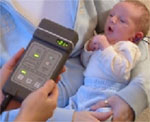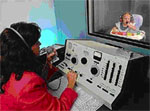Your child's audiologist will take a complete hearing history to help evaluate your child’s hearing, There are many different types of hearing tests that can be used to check your child’s hearing. Most audiologists will use several different tests to get a complete picture of your child's hearing. Some tests can be used for all ages of children, while others are used based the child’s developmental stage.
Evoked otoacoustic emissions (EOAE)
A test that uses a tiny, flexible plug that is inserted into the baby's ear canal. Sounds are sent through the plug. A microphone in the plug records the otoacoustic emissions (responses) from the inner ear in reaction to these sounds. When the emissions are present it usually means that the hearing is normal. There may be many reasons why we are not able to measure emissions, including hearing loss. This test is painless and is usually completed within a few minutes, while the baby sleeps or is very quiet.

Photo of an EOAE test
Auditory brainstem response (ABR)
A hearing test that uses small disk-like sensors attached with adhesive to the baby’s scalp. While the baby sleeps, clicking sounds are made through tiny earphones in the baby’s ears. This test measures the hearing nerve activity in response to the sounds. This test is painless and takes approximately two hours. The test is either done in natural sleep (called an unsedated ABR) or if the baby isn't expected to sleep naturally for that long, a safe liquid sedative is prescribed by a Doctor and a nurse monitors your baby while the test is done (this is a sedated ABR).
Auditory steady state response (ASSR)
This is very similar to the ABR, and is also a sleeping hearing test that measures an electrical response of the inner ear and auditory nerve. For this test, small disk-shaped sensors are placed behind each ear and on your baby’s forehead. Sounds are then presented to the ears using miniature earphones. The test can be done either in natural sleep or with the use of a mild sedative, along with sleep deprivation techniques. The main difference between ASSR and ABR is that ASSR is usually faster to show that hearing is normal because both ears can be tested at the same time, whereas with ABR, each ear must be tested one at a time.
Visual reinforcement audiometry (VRA)
This hearing test is typically done for infants over six months of age. This test takes advantage of a baby's natural head turn to look for the source of sounds. It involves teaching your baby to turn to sounds by reinforcing the head turn with toys that light up. Sounds are presented through little plugs that fit in the ear canal, through headphones and/or speakers.

Photo of VRA
Behavioural Observation Audiometry (BOA)
A test used to observe hearing behaviour to sound when the head turn test (VRA above) is not possible. Additional testing is often necessary.
Acoustic immittance (also called tympanometry or impedance)
A test that helps determine how the middle ear is functioning. Ear infections affect the middle ear. This test does not show whether the hearing is normal.
Evaluation of hearing may include the tests mentioned above, along with the following:
Play audiometry
A test that uses playing games in response to sound. The toddler usually wears some type of earphones. The child is asked to do something with a toy (touch or move it, for example) every time the sound is heard. This test relies on the cooperation of the child.
Auditory brainstem response testing under sedation
This is a sleeping hearing test. A mild sedative is used to get the child to sleep. Small disk-like sensors are placed on the scalp and insert plugs are put in the toddler’s ears. While the child sleeps, clicking sounds are made through the plugs. This test measures the hearing nerve activity in response to the sounds. This test is painless and takes approximately two hours.
Evaluation of hearing for the child older than three to four years may include the tests mentioned above along with the following:
Pure tone audiometry
A test that uses sounds at different volumes and pitches with headphones over your child’s ears. In this age group, the child is simply asked to respond in some way when the tone is heard.
